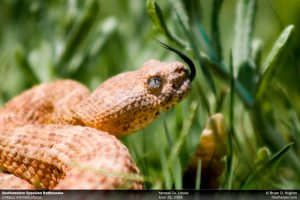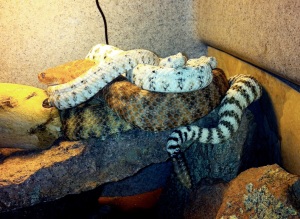Making the Switch to Keeping Rattlesnakes
“Why couldn’t it be baseball cards?” That’s what my dad says whenever he comes to visit, and I show him my captive rattlesnake collection. I know he’s kidding; he trusts me in what I do, but he makes a good point. Why, of all things to collect, did I end up with a bunch of venomous reptiles in my house?
I’ve only been keeping them for about a year and a half at this point, so I can’t really say much about expert keeping or give a lot of best practice information, but I can say a lot about one thing…the transition necessary to keep animals that can kill you.
Here’s how it happened. My primary interest in reptiles is, and has been since I was a kid, finding them in the wild. When I was a kid, it was garter snakes under boards in Oregon. At 31, it’s a lot of hard hiking for rattlesnakes. Even though I have a sizable collection (maybe 25 snakes at the moment), the field herping is my focus. I never expected to keep any rattlesnakes until I found one particularly pretty little speckled rattlesnake. It was from a location that is a bit special, so I wanted to take it home and return in favorable lighting conditions for photos…and that was that. A year and a half later, I have him, 2 other speckled rattlesnakes, a tiger rattlesnake, two Arizona black rattlesnakes, and a gravid diamondback. Whoops.
Why I Feel Safe.
This is the main reason my hobby is not especially dangerous: I have an almost annoying ability to carry out actions as procedures. I use my turn signal in an empty parking lot at 2 a.m.; I don’t speed; the backup system on my home computer is way overboard…that kind of thing. I’m good at taking an action and doing it the same way every time, and that is exactly what is required to safely keep venomous snakes. To refill the water, it means a visually locating our cats elsewhere in the house before locking the door to the room, removing the snakes and locking them into screw-top buckets, filling the water, and replacing them. It takes about 20 minutes to do, which makes them much more work than any other reptile I have ever kept.
I break this up into maintenance cycles. The idea is that, even if all steps are taken to keep absolutely safe, every time an enclosure is opened is a chance for something to go wrong. The easiest way to reduce that chance is to simply open the enclosures less often. I feed them all at the same time so they poop at the same time, and do my best to take the daily tasks of keeping any snake and make it something that I can prepare for and spend a couple of hours doing every other week or so. If I open the enclosures half as much, my chances of taking a bite are likewise reduced by half.
One unexpected upside to consolidating cleaning sessions is that I can get more detailed with the enclosure. My other snakes are in tubs in the same boring aspen, simple hide, and a rock to rub shedding noses on. The rattlers are in more elaborately decorated surroundings with multiple hides, ornamental skulls and the like, and a variety of rocks I have collected from the same areas where they were originally captured. Of course it takes more work to take a bucket of rocks out to clean, but when you only have to it once every other week, it isn’t much of a chore at all. In fact, I’ve very much come to enjoy my time working with them and keeping these displays in tip top shape. These snakes are art, and should be treated as such.
The snakes are in the standard, ugly, vision enclosures. They’ve solid, molded plastic with sliding glass doors. When those doors are locked, there’s no way even the strongest snake could nose out an escape. It also provides a very objective “safe” milestone after each maintenance session. “Click” goes the lock. Done.
Not Like Other Snakes
Rattlesnakes don’t do much. Unlike my colubrids, who spend each day crawling around the enclosure doing whatever it is they’re doing that day, almost all of the rattlesnakes’ time is just sitting coiled in various positions. That doesn’t mean that they don’t have personality, however. One of my AZ black rattlesnakes likes to sit in a spot out in the open and rattle at me whenever I come in the room, whereas his mate in the same enclosure stays mostly hidden, and only comes out for food or water. Everything seems to move slow and deliberate when compared to my colubrids. The journey to the water bowl is a long process of getting there, circling it once or twice, and doing a triple check to make sure nobody else is in the area before finally committing to the drink. They’re very interesting to watch at everything they do. Even when just sitting there in their coil, they seem to be pieces of art behind glass. The danger isn’t the draw at all, as anyone who would spend a few days watching these animals just do what they do.
Not For Everybody
While I keep and enjoy venomous snakes, I obviously do not recommend it for everyone. No matter how safe I believe myself to be, there is always that chance for something unexpected to happen and put me in the hospital, or worse. I am blessed with a great dedication to procedure and lack of interest in cavalier behavior, and I’ve certainly met my share of people who don’t hold such calculated actions in high regard. I would advise anyone who is thinking of bringing a deadly animal of any kind into your home, consider your reasoning. If you’re a clumsy type; don’t do it. If you’re a shortcut taker; this isn’t for you. If you feel you know snakes well enough and that’s what will protect you; you don’t, and you’re wrong. Before getting that first venomous snake, always ask yourself…how about baseball cards instead?
Bryan D. Hughes
We at Reptileapartment.com would like to thank Bryan for dropping by and writing this incredible article for us. All images and text of this post are under 2010 Copyright of Bryan D. Hughes and are used here with his express written permission. If you would like to contact Bryan regarding the use of his images the links above are provided to contact him directly.



